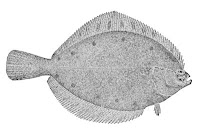Plaice is a collective name for several species of right-eyed flatfish that live in cool ocean environments.
Like most flatfish, plaice are excellent table fare, known for their mild, white flesh. Plaice are usually served fried, baked or grilled.
European, American, Alaskan, and scale-eye plaice
European plaice (Pleuronectes platessa) are identified by their brown or greenish brown upper-side skin, distinctive orange spots and bony ridge behind the eyes.
In the North Sea, plaice fisheries are important for nations such as The Netherlands, which holds over 50% of the European Total Allowable Catch. In many plaice fisheries, Dover sole is an important commercial by-catch.
The American plaice or dab (Hippoglossoides platessoides) is a "right handed" flounder, found mainly north of Cape Cod into the Arctic Ocean. In European waters, they range from England to Iceland.
The U.S. fishery is managed under the New England Fishery Management Council's Northeast Multispecies Fishery Management Plan (FMP).
Alaska plaice (Pleuronectes quadrituberculatus) are found in the North Pacific Ocean and Bering Sea. Like most flatfish, they live on the bottom of the continental shelf.
Scale-eye Place
The scale-eye plaice (Acanthopsetta nadeshnyi) is another flatfish of the northern Pacific, primarily living from the Sea of Okhotsk to Japan and Korea. Scale-eye Place are also found in the Bering Sea.
Plaice Fish Recipe
4 plaice fillets, skinned
1/2 pound button mushrooms, cleaned and sliced
flour
salt and black pepper to taste
1/2 cup dry white wine
1/2 cup cream
2 tbsp freshly chopped parsley
1. Melt 1/4 stick of butter in a large frying pan. Add the mushrooms and fry gently for 2 to 3 minutes. Remove from the pan and keep hot.
2. Coat the plaice in flour, salt, and pepper. Add an additional 1/4 stick of butter in the pan and add the fish.
3. Fry quickly until golden on both sides. Add the wine and simmer gently for 10 minutes or until the fish is tender, turning once during the cooking time.
4. Re-add the mushrooms to the pan. Stir in the cream and heat gently. Do not allow to boil or the cream will separate.
5. Transfer the fish to a hot serving platter and pour the sauce over. Sprinkle with chopped parsley and serve immediately.



